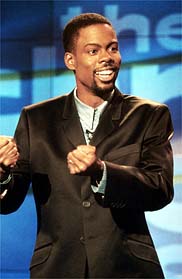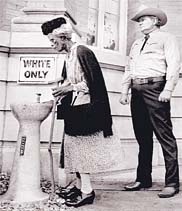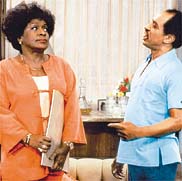February 1, 2002
An Evolving Vision in Black and White
By JULIE SALAMON
 |
| (David Lee/HBO) |
| Chris Rock, a subject of Comedy Central's "Heroes of Black Comedy." |
 |
| (CBS Photo Archive) |
| ``The Autobiography of Miss Jane Pittman.'' |
 |
| (CBS Photo Archive) |
| ``The Jeffersons.'' |
The three corporate moguls staring out from the cover of Newsweek last week were sternly conventional: dark suits, light shirts, conservative ties, close-cropped hair. Clearly Masters of the Universe, these newly appointed chief executives of Merrill Lynch, AOL Time Warner and American Express are remarkable-looking in only one way: they're all African-American.
Surely this is a sign that the world is hugely different than it was 50 years ago, when Eddie Cantor put his arm around Sammy Davis Jr. on a television variety show, an interracial gesture that instigated a wave of hate mail directed at Colgate toothpaste, the show's sponsor. Or than it was when the producer of "The Nat `King' Cole Show" was dressed down by an NBC executive who told him, "Nat is a Negro and most of these musicians are white and it looks like the white guys are working for a Negro."
Ancient history — or not? At the same time that the African-American titans appeared in stone-faced power poses on Newsweek, USA Today carried a report that not a single black or Hispanic can be found among the nation's governors or in the United States Senate.
Television reflects this dichotomy, and not just during Black History Month in February, with its onslaught of race-related programming. Yes, things have changed since Dick Gregory, on "The Steve Allen Show," taunted the audience: "Don't clap for me. Just take me to lunch when it's not Brotherhood Week." Racial barriers can seem eliminated from the tube. Oprah Winfrey is an industry all by herself. African-American judges, doctors and teachers have become commonplace on prime-time shows, which once limited blacks to playing maids and clowns. Black sitcoms have found a substantial power base on Fox, WB and UPN. HBO has been instrumental in promoting new voices — like Chris Rock — in African- American comedy.
Yet all-black dramatic series like "Soul Food" (on Showtime) are rare; there is not a single black drama on network television.
"I don't believe there's a black drama you can put on American television today that will succeed the way we need shows to succeed," says Steven Bochco, producer of "City of Angels," the short-lived 2000 hospital drama with an all-black cast. "I think there's too much resistance in the culture." Too bad the litmus test for network executives had to be a clunky show like "City of Angels."
With its distortion of reality, television may be a fun-house mirror, but it has also proved to be a reliable reflection of certain cultural verities. The medium has played a crucial part in shaping public perception of African-Americans, even as black performers have influenced the direction of television.
When Nichelle Nichols, playing Lieutenant Uhura on the original "Star Trek," wanted to leave the show because she was stressed out, the Rev. Dr. Martin Luther King Jr. urged her to stay. He recognized the symbolic importance, in the 1960's, of having a strong black woman appear on a television drama. Throughout the early days of television, recalls Maya Angelou, the poet and a star of "Roots," "you saw somebody black on television, you just ran to see who it was."
This troubled, dynamic relationship between a populist medium and an aggrieved minority population is the subject of "Inside TV Land: African-Americans in Television," a three-part series beginning tonight on the TV Land cable channel. Focusing more on sociology than aesthetics, the series emphasizes not just the importance of powerful artistic works like "Roots" and "The Autobiography of Miss Jane Pittman," but also the significance of raucous sitcoms like "Sanford and Son" and "The Jeffersons" — particularly to black audiences.
The series echoes the themes of "Primetime Blues," Donald Bogle's discerning book on the same subject. (Mr. Bogle was a consultant to the TV Land special.) Mr. Bogle wrote: "Black viewers might reject the nonsense of the scripts for some episodes of `Sanford and Son' or `The Jeffersons' or `Martin.' Or the evasions of an otherwise moving series like `I'll Fly Away.' But they never really rejected a Redd Foxx or a Sherman Hemsley or Martin Lawrence or Regina Taylor's Lily. What remained consistent throughout television history was that a group of dynamic or complicated or intriguing personalities managed to send personal messages to the viewers."
Old bugaboos are given a revisionist spin in "Inside TV Land." "Amos 'n' Andy," the radio vaudeville act that became a television hit in the early 1950's, was also widely reviled by civil rights groups, whose members called the characters offensive stereotypes. But with greater diversity on television has come more tolerance for shtick and less concern that a particular characterization might reflect badly on an entire race. So while Julian Bond, the civil rights leader, expresses continued disdain for "Amos 'n' Andy," Quincy Jones, the musician, acknowledges, "They had some funny material." Debbie Allen, the dancer and actress, goes even further: "I would no sooner try to take `Amos 'n' Andy' off the air than I would take Aunt Jemima off a pancake box."
"Inside TV Land" deals breezily with its provocative topic. Produced more dutifully than imaginatively, it is an encyclopedic enterprise with overtones of a tribute program, full of earnest self-congratulations. Though limited to variety, drama and comedy programs — there's no sports, news or Oprah — this breathless series seems to be scurrying as it covers 60 years of television.
A serious discussion of television's influence on black politics is impossible without examining news coverage of the civil rights movement. But even this limited approach is fascinating, touching on illuminating incidents and illustrated by vibrant clips that reflect television's absurdity, poignancy, importance and triviality. Some might find it worthwhile simply to ogle the young Harry Belafonte, stunning in a gleaming white shirt open to his waist.
On Monday, Comedy Central takes a narrower, but sharper, attitude in its more pointed five-part documentary series, "The Heroes of Black Comedy," which celebrates contemporary African-American humor and its effect on show business. By profiling artists like Mr. Rock, Whoopi Goldberg and Richard Pryor, and by examining the link between hip-hop music and comedy, this series grapples with the social currents that allow for a black American Express chief executive in a country with no black governors. It celebrates performers who have transformed the harshest realities of their lives into comedy that sometimes just mimics vulgar realities, but often provides brilliant social commentary, skewering blacks as well as whites.
In one routine, Mr. Pryor, born in 1940, recalls meeting his first white man, who came to the family's home in Peoria, Ill., looking for Mr. Pryor's mother, a prostitute. As a young comedian, Mr. Pryor turned the shock of this encounter into material, asking what would happen if blacks went through white neighborhoods doing the same thing?
The incident and Mr. Pryor's recollection of it provided a profoundly personal sociology lesson. "When the notion of race is laid down in that kind of way, I don't think you ever get over that," says Paul Schrader, the film director and writer.
These close-up portraits offer resonant personal stories, but the long lens of the "Inside TV Land" special provides valuable insights into the evolving ways race has been treated in popular culture. It shows an excerpt from the 1970's series "Sanford and Son," about a widowed junk dealer and his son. Mr. Foxx, as Fred Sanford, studies the evening television schedule and observes: "Flip ain't on, Cosby ain't on, Sammy Davis ain't on. I guess after 8:30 it's white night."
It had been white night throughout the early years of television, with black performers appearing mainly as accent notes on variety shows or as comic characters in series. Occasionally, in the 1950's, a serious black actor like Ossie Davis or Sidney Poitier was featured in such theatrical showcases as "The Philco Television Playhouse," carrying a double burden, dramatic and symbolic.
"Sidney had such a weight to carry to be the first black actor to achieve what he did in this town," says Diahann Carroll, with special empathy. Ms. Carroll starred in "Julia," a 1968 sitcom about a single black mother who was a nurse. The show dealt with racial prejudice, but in a jaunty, sitcom way that drew fire for having a heroine who was too assimilated into the white world.
Inevitably, a populist medium like television invites backlashes with every breakthrough — even the breakthroughs that seem almost impossibly mundane in retrospect, as when Cicely Tyson unnerved people by wearing her hair in an Afro on "East Side/West Side," a 1963 drama starring George C. Scott as a New York social worker. (Ms. Tyson played his secretary.)
A few years later Bill Cosby radicalized television simply by being cool and debonair on "I Spy," an equal partner with co-star Robert Culp. In the 1980's, in "The Cosby Show," Mr. Cosby was a more racially explicit hero as Cliff Huxtable, a physician and a family man married to a lawyer. The Huxtables were familiar to everyone who watched, but especially recognizable to African-Americans, who connected to the show's subtle yet thorough reflection of upper-middle-class black life.
"Inside TV Land" addresses the cynicism of network programming after the civil rights movement made it fashionable to more fully integrate television. When the political humor on "The Smothers Brothers Comedy Hour" became too pointed, CBS canceled it, despite strong ratings, and replaced it with "The Leslie Uggams Show," a lightweight variety program. "What better way to shut everybody's mouth than to bring a little chocolate bunny on to have her own show," recalls Ms. Uggams ruefully. "We were just there to take the heat off the fire."
When television began, official racial segregation was sanctioned in many states, and having a black actress play a maid on TV was considered, among African-Americans, both an insult and a coup. Now, blacks run some of the heftiest corporations in the United States.
But on television, with the emergence of new networks and proliferation of cable, there is a tendency to design shows for very specific audiences, which creates a new kind of segregation. There are entire programming schedules directed at teenagers, others aimed specifically at African-American audiences. Meanwhile, black characters are routinely included on mainstream shows like "E. R." and "The West Wing." The fire may be cooler, but race still matters.
Tuning In to Race
"INSIDE TV LAND: AFRICAN-AMERICANS IN TELEVISION," TV Land. In three parts: "Variety," tonight at 9; "Drama," Feb. 15, 9 p.m.; "Comedy," Feb. 22, 9 p.m.
"THE HEROES OF BLACK COMEDY," Comedy Central. "Episode 1: Chris Rock," Monday night at 10; "Episode 2: The Original Kings of Comedy," Feb. 11. "Episode 3: Whoopi Goldberg," Feb. 18. "Episode 4: Hip-Hop Comedy," Feb. 25. "Episode 5: Richard Pryor," March 4. The shows are a half-hour each except for the Pryor episode, which is an hour. All begin at 10 p.m.
Copyright 2002 The New York Times Company
![]()